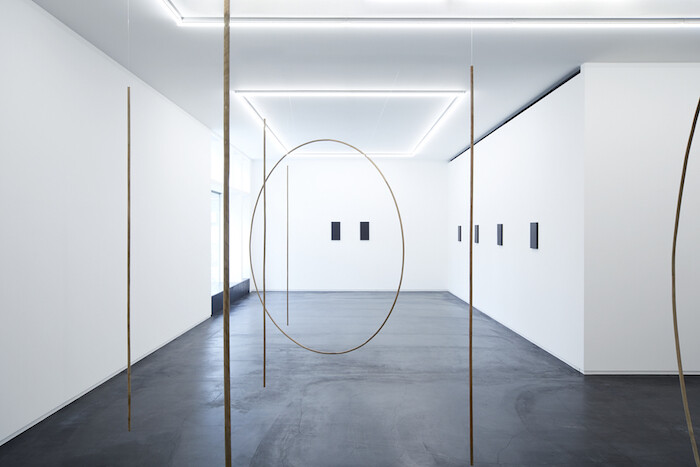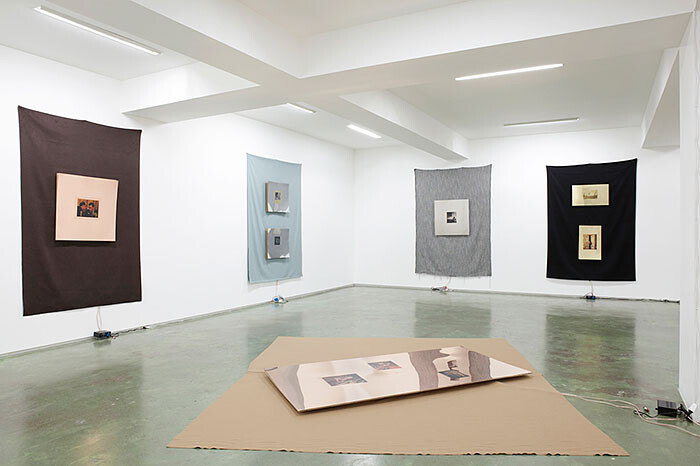Categories
Subjects
Authors
Artists
Venues
Locations
Calendar
Filter
Done
May 19, 2017 – Review
Maria Taniguchi
Cameron Allan McKean

Earth-stuff goes through myriad transformations on its path to usefulness in our world. Soil, stone, water, oil, plants, animals, and the rest all pass through processes of cleaning, smoothing, separating, reconstituting. And at the end of that violence is an exquisite, terrifying flatness: one that expresses itself through identical buildings, garments, and foods; through the identical spaces conveyed by this screen and the identical blackness inside it.
From her Manila studio, Maria Taniguchi makes work about the extraction of Earth-stuff—about its flattening and the entanglement of humans and nonhumans this transformation is contingent on. Born in the Philippines in 1981, Taniguchi works in installation, sculpture, and video, but she is best known for her nearly decade-long series of untitled paintings depicting a pattern of identical black bricks. Perhaps the plural is unnecessary: it’s really a single brick, roughly two by six centimeters, outlined in graphite on canvas or linen, and filled with black and gray acrylic. This brick repeats itself through her paintings, which seem to vary only by the size of their frame (from centimeters to meters) and the position they occupy in a gallery or studio. Her grid is uniform and endlessly scalable.
This brick helped win Taniguchi the Hugo …
October 1, 2014 – Review
Sarah Conaway and Melanie Schiff
Taro Nettleton

To coincide with his second exhibition in Japan, “BC RIPS” at Tokyo’s Taka Ishii Gallery, Sterling Ruby has curated a show of photographs by Los Angeles artists Sarah Conaway and Melanie Schiff. Held at the small Taka Ishii Gallery Modern space in Roppongi district and featuring just five images–one of a fallen tree and another of a plant from Schiff, and three photographs of fabrics variously folded and reposed from Conaway—it’s a difficult show.
Sarah Conaway’s three works are displayed across two different walls of the gallery. Two color images, Red and Yellow Fold (2011) and White and Blue Fold (2014), hang on one wall, while the third work, the black-and-white Religious Experience (2008), hangs on another. Conaway shoots mundane subjects that lack immediately apparent content. In doing so, and like those artists associated with the “Pictures” exhibition of 1977, organized by Douglas Crimp and credited with identifying a then new postmodernist approach to image-making, she explores the instability of meaning in any representation, even a photograph, which, as Roland Barthes famously pointed out, is assumed to be without code.
Simultaneously deploying the tropes of painting, photography, and sculpture, Conaway’s folded fabrics resist easy categorization. They are, however, consistent with Conaway’s studio-based …
January 22, 2012 – Review
Ei Arakawa and Sergei Tcherepnin
Kevin McGarry

The show ended in chaos, typically. On Saturday, January 14th, two incongruous flutists drifted into the exhibition space filled with visitors bending and shaking the cacophonous sculptures. It’s a scene that is only an amplified version of any given afternoon during the exhibition, throughout which the artists, Ei Arakawa and Sergei Tcherepnin, spent three hours daily on-site, demonstrating their conceptual instruments installed around the room.
With the series of six works each called Looking at Listening (2011)—five hung on the walls and one larger piece fixed to the floor—Arakawa and Tcherepnin created an environment where visitors could explore listening as a kinetic and potentially synesthetic process. The works consisted of metal panels imprinted with images and mounted on felt-draped devices—cool, clean, basic elements assembled like a science fair project, belying neither their mid-century performance art roots nor their unabashed functionality.
The images were sourced from the New York Public Library, where the artists found them catalogued in a file called “Listening” or in other categories which one could consider visual variations on the theme: “Conversation,” “Investigation,” “Town Meetings,” “Audience 1960s–70s.” In each, the act of listening is ostensibly underway, whether it’s a ruddy bureaucrat sticking his cocked ear through gilded doors, …
